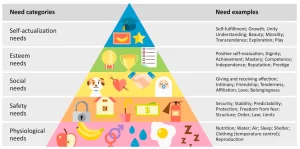The field of psychology has undergone so many changes since it first became an area of study. We no longer think that children are miniature adults with the same brain capabilities, we no longer think that babies should be left alone in their crib and not interacted with, and we certainly no longer encourage doing cocaine in therapy sessions (thanks Freud!).
There are, however, a few pieces of wisdom that have been so spot-on that they’ve endured for decades. One of those ideas is Maslow’s Hierarchy of Needs. First described in 1943 by Abraham Maslow, this pyramid gives us a simple and elegant way of thinking about our needs with regard to basic necessities, relationships, and self-fulfillment.
Let’s take a look:
Maslow’s Hierarchy of Needs

Looking at the pyramid, we can think of each section as building blocks. At the very bottom, our most important and fundamental physiological needs are food, water, shelter, etc, followed closely by safety and security. Next up is connection needs: a feeling of belonging, and caring relationships with others. On top of that is self-esteem needs, including personal achievement and mastery, feeling competent and respected by others, and having good self-esteem. At the very top we find self-actualization. This is something Maslow predicted only a small portion of the population actually achieves. Self-actualization is the idea of a person reaching their full potential. They have all of their needs on the pyramid met and so are free to reach a level of morality, creativity, and spontaneity that gives them a feeling of true fulfillment.
Disclaimer: These Are Not Hard and Fast Rules
This pyramid is not suggesting that a person can’t have their needs fulfilled in a category if a lower category of needs is not being met; it’s saying that it’s harder for that to happen. For example, a kid who is housing or food insecure (physiological needs) may find it difficult to fully focus on their classwork (self-esteem needs) because they’re likely worried about meeting a more basic need. Likewise, a person who has experienced feeling emotionally or physically unsafe in relationships in the past (safety needs) may find it difficult to be vulnerable and fully connected in their relationships in the present (connection needs) because they’re on the lookout for danger and focused on self-protection.
It’s About Awareness and Self-Compassion
This pyramid is about awareness of our needs and what could be keeping us from feeling really fulfilled in a certain category. It’s about having compassion for ourselves and understanding that it could be difficult for anyone to feel fulfilled if certain important needs aren’t being met. The pyramid can also be a guide for how we think about getting our needs met so that we can fully enjoy what life has to offer.
How Do We Get Our Needs Met?
Physiological Needs: Drink water, eat consistently (not too much or too little), get enough sleep at night (6-8 hours at least), have reliable shelter and heat. Remember to rest! These seem so basic and yet everything else depends on them.
Safety Needs: Be physically in a place where you feel safe. Develop relationships with people who respect you and the boundaries you set. Practice setting boundaries. Respect your own needs and take them seriously. Be selfish when you need to. Build a sense of predictability and structure in your life, however that makes sense to you.
Connection and Belonging Needs: Show and receive affection and tenderness. Connect with others on an intimate level. Laugh with your friends. See people you care about in person if possible. Have a phone/video conversation instead of texting. Give and get hugs. Say “I love you”.
Self-Esteem Needs: Build mastery and competence in a chosen area. Remind yourself of your good qualities. Keep letters or emails of others complimenting you and read them when you feel down. Ask others what they like about you, try to get it in writing. Think about where you started and how far you’ve come already. Remember that there will always be another goal post to reach, and practice feeling gratitude for what you have already accomplished.
Self-Actualization: Let yourself be playful and spontaneous. Explore hobbies, be creative, make art, dance. Decorate your space. Appreciate the beauty of a forest or some graffiti artwork. Practice generosity and selflessness. Do something to help someone else.
Bringing it Home
How about you? Was there a category of needs in this article that made you sigh in recognition or cringe with anxiety? If you’re feeling burned out, which of these needs are not getting met in your day to day life? In what areas have you been neglecting yourself? What are small or big steps you can take towards getting more balance with the things that are important to you?
Find balance, feel at peace. Reach out and connect with an Austin EMDR therapist today.


